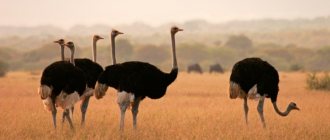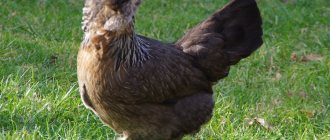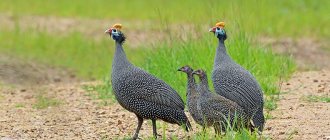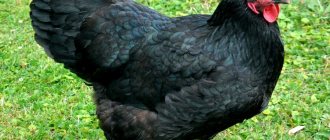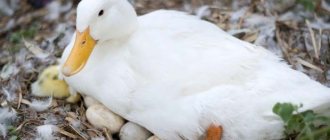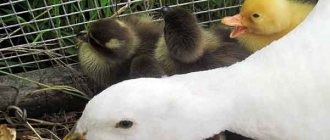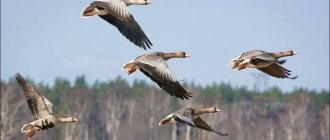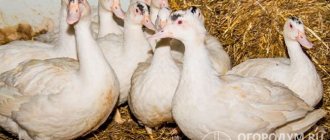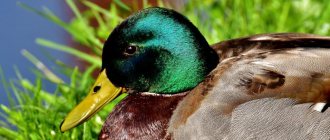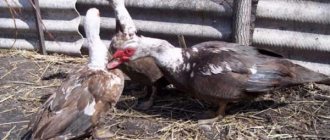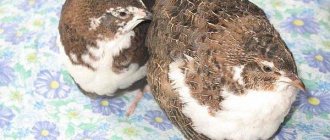Home » Articles about ducks » French ducks
French ducks were bred by Orvia. They are suitable for growing on farms and poultry farms and provide good yield of meat, liver, and eggs.
Description of the breed
French ducks are derived from four lines of the Peking breed. They are known as the Orvia ST5 cross and belong to the meat and egg category. In ST5, the difference in weight between females and males is very pronounced - the drakes are 1-2 kg larger.
Ducklings are born with yellow down, their paws and beak are pink. Adult ducks of the French breed have a massive short neck, a large rounded head, and an orange beak. Their body is dense and elongated. A characteristic feature of birds of both sexes is a wide chest. This is noticeable already at an early stage of growth. The wings are pressed tightly to the body. The tail is small, slightly raised. The paws are strong, set wide, and colored orange. The plumage is white and dense - it is valued on the market, which allows the farmer to receive additional income.
Requirements for premises and care
To keep Star-53 broilers you need to equip a warm, dry and free room. It should be light and the bedding, feeders and air should be kept clean. Since Star-53 ducks have an accelerated metabolism, the bedding will have to be cleaned frequently, but this is a necessary measure, because in dirt and in an unventilated room the birds get sick and die. The floor of the poultry house is covered with straw or hay, sawdust, and peat.
The placement rate is no more than 2-3 Star-53 ducks per square room. Overcrowding should not be allowed, this will lead to diseases, the birds become restless and attack each other. You should also not keep birds in a stuffy environment or allow them to breathe stale air. The poultry house needs to be ventilated every day, and it is better to leave it open while the bird is walking. 3-4 hours of walking is quite enough, since the duck is a broiler, excessively active movement will not allow it to gain weight by the due date. The same goes for swimming. When a duck swims, it spends energy, which affects its weight gain. In addition, the white plumage becomes dirty, especially on the belly and chest. And from eating fish and aquatic food, the meat acquires a fishy smell, which not everyone likes.
Description and habitat of sad ducks, what the scoter eats and the character of the birdRead
But you can’t keep ducks locked up, despite the short fattening period. To walk Star-53 hybrids, you need to equip a walking yard next to the poultry house. Its area is 1 sq. m for 2 ducks. In the yard you can feed the bird green grass. You need to put drinking bowls in it and change the water every day.
If you plan to raise a lot of Star-53 ducks, then it is better to organize automatic ventilation, feeding and watering systems. Temperature conditions are also important when raising both young and adult ducks. If ducks are hot, they begin to pant and reduce their feed intake. If it’s cold, they huddle together and eat a lot, but there is no increase in weight gain, since energy is spent on warming the body. Therefore, if ducks are kept in winter, you need to take care of insulating the house.
Productivity characteristics
French ducks are a meat breed with good growth rates. Already at 7 weeks they can be sent for slaughter upon reaching a weight of 3.5-4 kg. The meat at this stage of fattening is juicy, tender, and not very fatty. Such results can be achieved with moderate feed consumption - about 1.88 feed units are required per 1 kg of weight gain.
Duck liver is large - 500-700 g. It is used for the production of liver pates. The breed has high egg productivity - during the year, ducks lay 250-280 eggs weighing 88 g (the maximum is 296 pieces). The product tastes good.
Reviews
Feedback from farmers about Star 53 ducks is overwhelmingly positive.
The main advantages of these birds are presented:
- Their external attractiveness.
- Undemanding to care and living conditions.
- The ability to quickly (the bird is ready for slaughter on 45–50 days of growing) to obtain meat. At this point, the weight of duck carcasses reaches 4.5 kg.
- Large yield of clean meat from each carcass. In terms of fillet yield, the Star 53 breed is superior to all other duck breeds.
- Excellent egg production and impressive egg weight.
- Minimal (no more than 16%) fat content of meat and its excellent taste, allowing it to be used for dietary purposes.
- Low cost, endurance and unpretentiousness of ducklings, not susceptible to disease and characterized by minimal mortality.
- Incredibly fast growth, allowing you to raise at least four batches of ducks during the warm season.
- Maximum profitability of cultivation due to the relatively small amount of feed required.
- The ability to fully reproduce. The eggs of this breed are perfectly fertilized and produce healthy young.
Poultry farmers name the following disadvantages of the breed:
- Tendency to severe soiling of the plumage on the chest and belly, which is a consequence of a very low body position.
- Excessive “talkativeness” of ducks, loudly and actively quack even at night.
- The unsuitability of females for incubating eggs, as a result of which the farmer will have to either purchase an incubator for breeding offspring, or use a duck of a different (most often musky) breed as a brood hen.
- Poor tolerance to damp rooms.
- Insufficient stress resistance.
Breeding Features
Since the description indicates the hybrid origin of the breed, French ducks are not bred within the flock. Incubation material or ducklings have to be purchased. Store eggs before laying at a temperature of +8...+12°C and air humidity of 70-80%. To avoid the development of pathogenic bacteria in a warm, humid environment, the shells are disinfected.
The maximum shelf life of duck eggs is 8-15 days. Subsequently, the percentage of excretion decreases greatly. Incubation takes four weeks:
| Duration (days) | Humidity (%) | Temperature (°C) | Revolution (once a day) |
| 1-7 | 70 | + 38 | 4 |
| 8-25 | 60 | +37.8 | 4 |
| 26-28 | 85 | +37.5 | — |
From the fifteenth to the twenty-fifth day, the eggs are cooled twice a day for 15-20 minutes. The exit is usually amicable, it occurs on the twenty-eighth day, but it may be delayed.
Origin
The Peking duck Orvia cross ST5 (ST5) was bred in France. This is a meat bird; the hybrid is used for industrial cultivation. The cross was obtained from 4 selected pure lines of the Peking breed. The improvement of the cross was carried out after 2004, and now the company supplies poultry to 4 continents. Ducks have typical broiler characteristics; they fatten up quickly, which is why they are valued by poultry farmers. Simultaneously with the Peking duck cross, the company developed Muscovy duck hybrids - the ST6 C and ST6 LC crosses.
Rules for keeping ducklings
In the first days, the temperature is maintained under the heater +30…+32°C. Lighting at this stage should be around the clock. The temperature is reduced by 1°C daily. They stop at +22°C. At one month of age, the ducklings are moved to a common room, but they are given a separate enclosure.
How much ducks of the French breed will weigh depends on the quality of the starting fattening. Ducklings are ready for an adult diet no earlier than three weeks. In the first days they are fed chopped boiled eggs and millet. Water is provided only in boiled form.
From the third day, well-washed chopped greens are added - alfalfa, knotweed, clover, nettle, and green onions are suitable. From the age of one week, wet mash is prepared based on corn and wheat. It is useful to add fish oil to them.
In good weather, two-week-old chicks begin to be accustomed to grazing on grass - portable enclosures are used. The duration of walks is gradually increased. Ducklings are provided with mineral supplements (egg shells, limestone) and fine gravel. Gradually the diet is expanded.
Feeding of young birds
On the first day, the chicks are given finely chopped boiled eggs, which are well digested by the stomach of young birds. For drinking, add a little manganese to the water so that the liquid is slightly pink. At the next feeding, low-fat cottage cheese or other dairy products are added to the eggs.
Young animals need a sufficient amount of green crushed feed, which is introduced from the second or third day. Green onions, lettuce leaves, young nettles, and duckweed are suitable.
At the age of 1-2 weeks, boiled boneless fish and fish oil are desirable. From the second or third week, small ducks begin to be fed like adult birds.
Conditions for keeping ducks before slaughter
Due to their rapid growth, French ducks are usually raised for up to one and a half to two months. They are kept longer for eggs or for fattening for the liver - in accordance with the description of the breed, the birds have good performance in both areas.
For year-round rearing, an insulated poultry house is prepared; heating is required in winter. The birds are kept on a bedding made of hay, straw, and sawdust. The temperature should not fall below +8°C. The poultry house is kept clean and has good air exchange (no drafts).
The advantage will be the presence of a pond in the walking area. If it is not available, you will have to dig an artificial pond or install troughs for swimming.
Well-organized care
Straw bedding for ducks
A dry, thick layer of straw bedding will serve as additional thermal insulation for the room in winter. It will also allow the ducks to build nests or hide out to stay warm if the house gets cold. To combat harmful microorganisms, a thin layer of lime fluff is scattered on the floor under the straw.
Regular care involves carefully monitoring the dryness of the litter and replacing it as necessary. In summer, on hot days, the straw can be removed, since the Hungarian will spend a lot of time grazing in order to fully realize her needs for fresh grass. To improve digestion and saturate the duck’s body with the necessary minerals, shell rock or chalk should always be present in a separate feeder. The motley Mulard attracts potential owners with its resistance to typical diseases, which it inherited from its parent breeds.
Have you ever experienced unbearable joint pain? And you know firsthand what it is:
- inability to move easily and comfortably;
- discomfort when going up and down stairs;
- unpleasant crunching, clicking not of your own accord;
- pain during or after exercise;
- inflammation in the joints and swelling;
- causeless and sometimes unbearable aching pain in the joints.
Now answer the question: are you satisfied with this? Can such pain be tolerated? How much money have you already wasted on ineffective treatment? That's right - it's time to end this! Do you agree? That is why we decided to publish an exclusive interview with Professor Dikul, in which he revealed the secrets of getting rid of joint pain, arthritis and arthrosis.
Feeding adult livestock
The diet of ducks includes:
- cereals (wheat, corn, barley, oats);
- legumes;
- bran;
- cakes and meals;
- yeast;
- grass, aquatic vegetation and vegetables;
- dairy products;
- fish and bone meal, fish waste;
- sources of calcium (shells, shells, chalk).
Digestion requires coarse sand or fine gravel. The frequency of feeding is from two to four times, depending on the conditions of detention (with or without walking) and age (young animals are fed more often). It is convenient to use ready-made mixed feed for feeding - they contain all the necessary components. PC 21-1 is suitable for the starting stage. From one month of age, PC 24-1 is indicated.
Health
In accordance with the description of the breed and reviews from owners, French ducks have a strong immune system. If the conditions of detention are observed, they get sick infrequently, but problems cannot be ruled out.
When feeding low-quality feed and large products, goiter catarrh may occur. When there is a deficiency of proteins and vitamins A and E in the diet, egg pecking occurs. In young ducks, inflammation and prolapse of the oviduct may be detected - as a rule, this occurs when large eggs are laid.
Infectious diseases develop under unfavorable epidemiological conditions in the district. The most dangerous of them:
- aspergillosis;
- coccidiosis;
- pasteurellosis.
If weakened individuals are identified in the herd, it is necessary to remove them from the rest and show them to a veterinarian. The poultry house must be disinfected. Healthy livestock are given prescribed medicine to prevent infection. It is important to prevent drafts in the room, control the quality of products and comply with feeding standards.
Diseases
ST-5 ducks do not get sick with good care and quality food. If proper maintenance standards are not observed, they are susceptible to the following diseases:
- Avitaminosis.
- Poisoning.
- Inflammation and blockage of the goiter.
- Hepatitis.
- Salmonellosis.
- Parasitic diseases.
- Parasites
- Infectious
- Other
Coccidiosis
How to identify the disease and how to treat it? What is important to know about prevention?
Read
Worms
Worms are round worms (helminths) that cause various diseases and, as a result, serious disorders in the body of birds
Read
Aspergillosis
An infectious disease caused by fungi that affects the respiratory organs and leads to the death of the bird
Read
Pullorosis
Pullorosis (typhoid, salmonellosis): description of the disease, symptoms, treatment, preventive measures
Read
Hemophilosis
Contagious runny nose is a dangerous respiratory disease that can lead to the death of the entire livestock
Read
Pasteurellosis
Basic characteristics of the disease, methods of prevention and basic principles of treatment
Read
Marek's disease
What to do when poultry suffers from Marek's disease (neurolymphomatosis, avian paralysis)
Read
Cloacite
Inflammatory disease caused by errors in feeding and keeping poultry
Read
